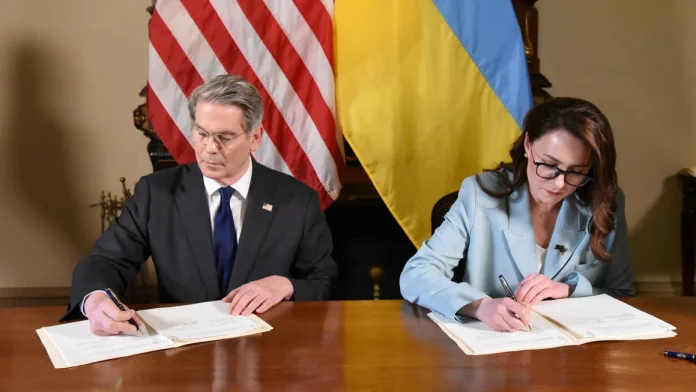
The United States and Ukraine have finalized an “economic partnership agreement” granting Washington preferential access to Kyiv’s mineral resources in exchange for a joint investment fund in Ukraine.
The deal follows months of difficult negotiations that began after President Donald Trump returned to office in January. Compared to earlier drafts, the final agreement is more balanced, no longer requiring Ukraine to reimburse past U.S. military aid. Instead, future assistance will count as part of the U.S. contribution to the investment fund.
President Trump described the agreement as a strategic move to “protect” U.S. interests, saying, “We made a deal today where we get much more, in theory, than the $350 billion, but I wanted to be protected. I didn’t want to be out there and look foolish.”
Trump has previously overstated U.S. aid to Ukraine, falsely claiming $350 billion had been provided since the Russian invasion in February 2022. The actual amount is closer to $120 billion, according to the Kiel Institute for the World Economy.

The agreement grants Ukraine full ownership and control of its resources. Ukrainian Economy Minister Yulia Svyrydenko emphasized, “All resources on our territory and in territorial waters belong to Ukraine. It is the Ukrainian state that determines what and where to extract.”
The signing was almost derailed by last-minute disputes over documentation but was finalized in Washington. Ukraine’s Prime Minister Denys Shmyhal clarified the deal does not retroactively include assistance provided before its signing and described it as “an equal and beneficial agreement on joint investments in Ukraine’s development and recovery.”
In a shift from previous rhetoric, the U.S. Treasury referred to the war as “Russia’s full-scale invasion” and described the agreement as a “historic economic partnership.” Treasury Secretary Scott Bessent stated, “This agreement signals clearly to Russia that the Trump administration is committed to a peace process centered on a free, sovereign, and prosperous Ukraine.”
The pace of implementation remains uncertain due to the ongoing conflict. However, both nations agreed to establish a jointly managed fund with equal contributions. New U.S. military aid may count as part of Washington’s investment.
Negotiations had previously stalled over security guarantees, with Trump initially insisting Ukraine sign before any such assurances were discussed. During a February visit to the White House, Ukrainian President Volodymyr Zelensky declined to sign an earlier draft, describing it as asking him to “sell” his country. The fallout included a temporary suspension of U.S. aid to Ukraine, which was later reinstated and prompted greater commitments from European allies.
Trump has promoted the deal as Ukraine “paying back” for previous U.S. support. Treasury Secretary Bessent told Fox News the agreement was “a signal to the American people that we have a chance to participate and get some compensation.”
Ukraine holds deposits of 22 of the 50 materials classified as critical by the U.S. Geological Survey, including rare earth elements vital to electronics, green energy technologies, and weapons systems. As China dominates global supply, Ukraine’s resources present an attractive alternative for the West.
The U.S. had already expressed interest in Ukraine’s mineral potential under the Biden administration. A 2023 memorandum aimed to encourage U.S. investment in Ukrainian mining in exchange for economic incentives and environmental standards. Ukraine also signed a similar agreement with the European Union in 2021.



